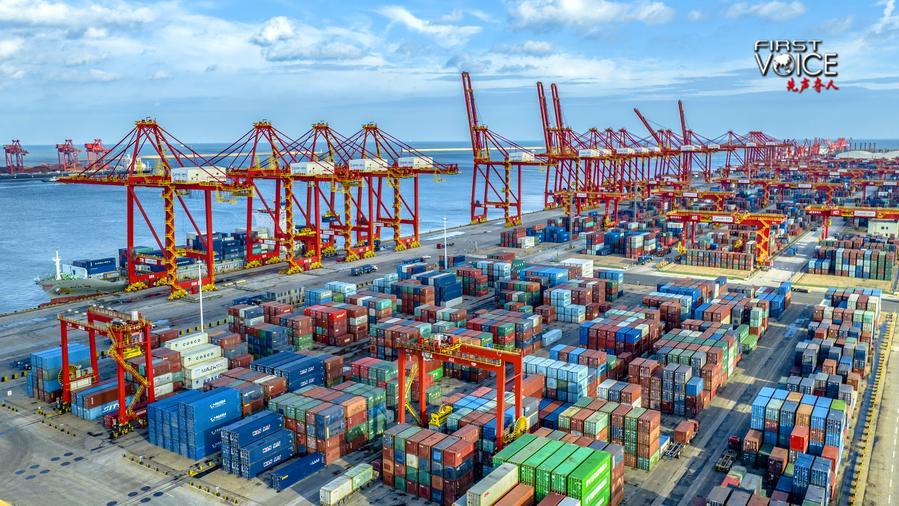
A view of Rizhao Port in Rizhao, east China's Shandong Province, July 2, 2024. [Photo/Xinhua]
Editor's note: CGTN's First Voice provides instant commentary on breaking stories. The column clarifies emerging issues and better defines the news agenda, offering a Chinese perspective on the latest global events.
After being dormant for about a decade, the term "China shock," coined in the mid-2010s, was dug out late last year to target China's industrial capacity.
Earlier this week, Lael Brainard, U.S. President Joe Biden's top economic adviser, told the Detroit Economic Club that tariffs are needed to avoid a second "China shock." This is the second time in half a year that Brainard, a member of the White House's economic "brain trust," has publicly cited a "China shock" in supporting the Biden administration's China trade policy.
The "China shock" was invented by a handful of American economists, referring to the considerable growth in Chinese imports into the U.S. after China's accession to the World Trade Organization (WTO), which was said to have cost the U.S. millions of jobs and to have wiped out its manufacturing.
Although the proposition was described as critical to U.S. trade policy, especially in defending its trade tariffs on China exports, more and more economists revealed, contrary to what it is stated, that the U.S. got net economic gains during the "China shock" period.
Some found that the final effects of the "China shock," which caused losses in manufacturing jobs, were offset by gains in non-manufacturing jobs, such as those in the service sector. Others found that though specific positions were lost due to the supply chain readjustment, overall employment and wages increased in the U.S. More importantly, after examining the consumer and aggregate economic effects of U.S.-China trade ties, it's estimated that, overall, American consumers saved around $400,000 per every U.S. displaced manufacturing job.
To sum up, with average people's overall living standards improved, the consequence of the "China shock" is shockingly in contrast to what the hypothesis is designed for. To professional economists, the "China shock" outcome is not unrepresentative. It's a by-product of economic globalization.
However, to the priests of policy in Washington D.C., the "China shock," resonating with bitter memories of manufacturing workers and communities, was introduced to win this targeted group's ballots in this election year. Coincidently, it was in 2016, also an election year, that the term first caught the public's attention.

The U.S. Capitol building in Washington, D.C., the United States, October 11, 2023. [Photo/Xinhua]
The ill-founded "China shock" is simply another version of the "China threat theory," another term to discredit China. It also highlights a dark psychology of neocolonialism – in the global trade system, developing countries can be exporters of mining products, agricultural products, and low-end manufactured goods. But should they upgrade their capacity and start exporting high-value-added goods, they become threats. The logic behind this is simple – developing countries can only passively accept manipulation of the developed world.
Unfortunately, after actively cooperating with industrialized countries, China has become the only country in the world to obtain all the industrial categories listed in the UN industrial classification. The country has long been a champion of economic globalization, especially since the reform and opening-up in the late 1970s. If a country's involvement in the global division of labor brings "shocks," China is contributing positive "shocks." As the largest trading partner to over 120 countries and regions, the country's contribution to global economic growth has reached approximately 30 percent.
Besides trade, with financing, technological transfer, talent training and infrastructure construction with other developing countries, China has brought economic globalization to a new height. Under the Belt and Road Initiative, projects, such as the China-Laos Railway, the Jakarta-Bandung High-Speed Railway and the Mombasa-Nairobi Standard Gauge Railway, not only promote regional connectivity, but also generate tens of thousands of jobs for the locals, bringing tangible improvements to people's livelihoods.
Be it net economic gains to developed countries or palpable betterment of daily lives to people in the developing world, if there are"shocks" brought by China, they are positive ones.

 中文
中文



